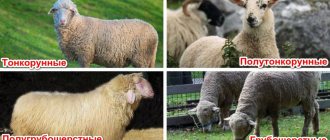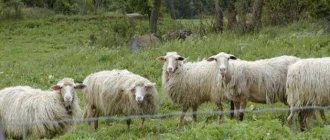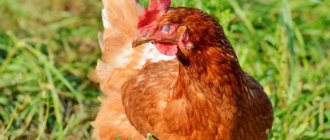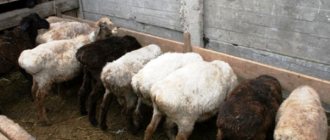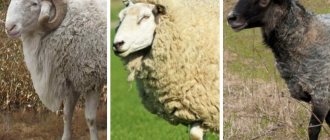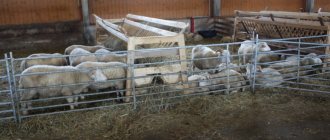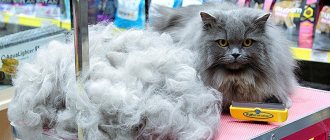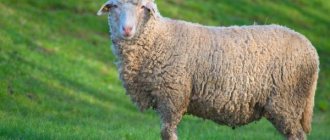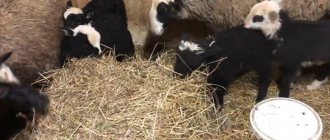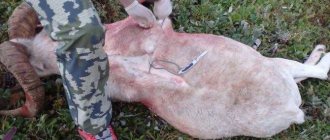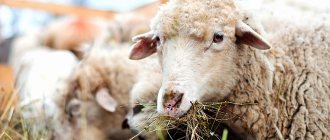Sheep farming, how to shear sheep, shearing sheep, machine shearing sheep, machines for shearing sheep.
As you know, sheep are kept not only and not so much for meat, but for their wool; besides, this resource is renewable and generates income. Therefore, the topic of sheep shearing is always in demand and interesting to farmers. Previously, sheep were sheared by hand, but over time, technology is developing and in most large farms, machine shearing is used for shearing. Manually shearing sheep is a very labor-intensive process; you won’t be able to shear more than 30 sheep a day, which is basically normal if you have a small number of sheep. If you have a large herd, or it’s simply expensive to spend a lot of time on shearing, then a sheep shearing machine is what you need, with its help you can shear 2-3 times more sheep without spending great strength. the New Zealand method of shearing sheep has become very fashionable ; it is very fast.
Sheep shearing is a mandatory procedure in fine-fleece and semi-fine-fleece sheep farming, even if you are not going to sell the wool or use it in any other way.
This procedure improves the coat, trimming is carried out as the coat grows, and attention is also paid to its condition. Often, female sheep are sheared a month before lambing, while the rest are sheared before going out to pasture. The wool is also trimmed, if in some specific areas it needs it; not the entire sheep is sheared, but problem areas.
The catching of sheep and subsequent transportation to the place of shearing takes place, as when shearing, using the high-speed method, the shearing begins from the right paw up to the sternum, then the same procedure is done with the left paw. They pass with a machine from the metacarpal joint to the end of the paw and back. Then they begin to cut the head, after that, they cut near the udder and in the lower abdomen, covering the nipples with one hand, the next in line is the inner surface of the hind legs, after that they move to the back, starting from the tail area. Is it worth mentioning that the person who picks up the wool must divide it into 3 parts: “cut”, “dung” and “foot” and pack them separately.
All livestock (if these are coarse-wool and semi-coarse-wool breeds) lambs are shorn, shorn in the first year of life, semi-fine-wool and fine-wool breeds - by choice. Breeds of coarse-wool and semi-coarse-wool sheep are sheared at the age of six months to eight months; when shearing semi-fine-wool and fine-wool sheep, they are guided by the following principles; if lambs are sheared when their wool reaches a length of 5-6 cm, and they should be born in winter or early spring, and have a given coat length at the beginning of August. When fine-fleece and semi-fine-fleece breeds have colored coats or health problems, they are not shorn.
Sheep shearing requirements:
- -A working machine for shearing sheep, without any problems in operation.
- -The cutting pair should under no circumstances be dull.
- -You must ensure complete grip of the fur.
- -Follow safety precautions
- -Do not skip sections of wool; if there are tufts of wool left, go through the machine again.
- -Maintain the integrity of the fleece.
- -Try not to injure the animal, handle it with care.
After shearing, the sheep should be examined by a veterinarian or senior shepherd and, if necessary, provided medical assistance. After inspection, it is necessary to carry out preventive treatment of sheep. Do not forget that after shearing, sheep are susceptible to colds, so during the first days of cold weather or rain, sheep should be kept in warm rooms.
This concludes our article on sheep shearing, we hope our tips can help you choose which method (manual or using a sheep shearing machine) is right for you, see you next time and good luck in sheep farming!
Liscop
There are many reviews about the manufacturer Liscop, and specifically about the Liscop Super Profi 3000 model. The manufacturer is German, so excellent quality is guaranteed. In fact, this is immediately noticeable. At a high cost - almost 30,000 rubles - the model is distinguished by its functionality, high speed of operation, and reliability of operation. The machine does not vibrate in your hands, works neatly and silently, which makes the haircut process easier.
The brand pays attention to improving technologies and materials; developers improve the quality of their products every year, refining certain systems.
Liscop Super Profi 3000 allows you to shear about 1000 heads of livestock during the season, while the power of the device is enough for such a number of sheep and rams. The long cable – 5 m – allows you to use the device in almost any conditions. The motor is housed in a reliable housing made of fiberglass-reinforced plastic, which reduces the weight of the structure. In general, customer reviews agree that the model is simple and convenient for use at home.
How to properly shear sheep
Sheep shearing is a procedure regularly carried out by sheep farmers, regardless of the purpose of breeding the animals. Even if they are raised not for wool, but for meat production, it is necessary to shear sheep, because overgrown fur falls off, dries worse after rain and disrupts normal thermoregulation - an unshorn animal is more susceptible to disease. To make the work faster and more efficient and not harm the sheep, you need to know the rules of shearing and the features of caring for the tool - scissors or an electric machine for shearing sheep.
Raising sheep for wool
Takumi
Buyers did not ignore models from the Japanese brand Takumi in their reviews.
Like any equipment from this country, this model attracts attention primarily due to its quality and reliability. The powerful motor makes it possible to easily cope with shearing about 300 sheep, while the cable is long and reaches 6 m in length
The weight of the structure is 1.4 kg. The wheels are made from steel, and the electric motor runs quietly. The manufacturer has developed a number of recommendations for caring for this device.
- The machine and the blades, free of wool, grease and sweat, should be stored in a dry room at room temperature.
- Before use, it is necessary to place the supplied drops into the machine every 20 minutes.
- During operation, it is important to monitor the voltage status in the network. If there is a voltage drop or if you press too hard, the machine will lose power.
Features and timing
The first thing you need to know is when to shear your sheep. In this case, two factors should be taken into account: weather conditions and how overgrown the animal is.
The main condition is consistently warm weather, otherwise the furless animal may freeze and get sick. However, you should not wait for the July heat - fur protects the sheep not only from the cold, but also prevents it from overheating.
This is interesting: Torn cascade haircut for medium hair 2019
If sheared in hot weather, she may lose her appetite, which will affect income if animals are raised for slaughter. In addition, in summer, wool is easily contaminated with burdock and other plants, which causes sheep shearing knives to wear out faster and the fleece to lose quality.
Sheep before shearing
The rate of hair growth and its structure determine the frequency of haircuts. If the fleece is homogeneous, the procedure is carried out once a year, if mixed - twice a year. Most often, sheep are sheared in the spring, before the beginning of June. The second time the wool is removed at the end of summer, no later than September, so that the animals have time to grow it back before the onset of cold weather.
Particular attention should be paid to lambs and rams with mixed wool. The cubs are shorn when they reach 5 months of age. If their wool is thin or semi-fine, you need to wait until it grows at least 4 cm. Rams definitely need to be sheared before the heat sets in, since when it warms up they begin to shed and lose fluff - shearing sheep will become less profitable.
It is best to do this in the spring, without waiting until June.
General instructions for the procedure
To achieve the maximum possible result from sheep shearing, you will need to strictly follow some rules to ensure quality work:
- The room chosen for processing animals must be not only clean, but also dry;
- Fifteen hours before the start of such a procedure, the sheep should be deprived of any feeding. This measure protects the animal from possible disorders in the intestinal tract. Then the procedure will be carried out in more pleasant and simpler conditions;
- When the process is completed, carefully treat the wounds of your sheared individuals resulting from the careless movements of the shearer;
- Once the wool has been completely removed, there is no need to give the sheep a lot of feed. A forced measure of restriction in feeding can somewhat upset the processes in the digestive tract and cause undesirable signs of indigestion;
- It is also not worth taking the flock long distances for grazing. If bad weather happens unexpectedly, they may catch a cold and even get sick;
- If the climatic conditions of the region are quite hot, then driving sheep to pastures should be carried out very early in the morning. This is the only way to protect animals from sunburn. The best salvation from severe burns is to build a canopy on your own or drive them to another shady place.
In fact, in practice, cutting a haircut turns out to be not such a difficult task.
You just need to adhere to all the established rules, and also ensure that they are carried out correctly.
Advantages and disadvantages of different types of haircuts
You can use sheep shearing scissors or different models of electric sheep shearing machines. The choice is based, first of all, on how many heads need to be shorn - if the herd is large, there may simply not be enough strength to process it with hand tools; but scissors are much cheaper. Both options have both their advantages and disadvantages.
There are two types of manual sheep shears:
- Double - this type of tool is easier to work with and is better suited for beginners;
- Single knives are essentially two knives cast from a single piece of metal, which means they require more strength to operate.
Manual shearing of sheep - with scissors
Manual shearing of sheep has two advantages: mechanical tools are cheaper than electric shears, more wool is cut, since the knives can be closer to the skin of the animal. Because of this, this method is more economically beneficial for small farms.
There are more disadvantages to shearing sheep with scissors:
- Labor intensive - you have to perform a large number of monotonous actions;
- Danger - without experience it is easy to injure the skin;
- Duration - the work takes more time, and a large livestock may not be able to be shorn in time;
- Possibility of damage to the fleece.
If you don’t have the skills to remove wool, it’s better to pay attention to sheep clippers - they are more expensive, but they will last a long time, so the costs will definitely pay off.
Sheep shearing with a clipper
Electric shears allow you to quickly process large livestock without difficulty for the shearer or harm to the animals. Their only drawback is their higher price. It is worth noting that even when using a machine, you still need to have scissors to cut out tangles.
Methods: by hand or by machine
Sheep can be sheared in two ways:
- manual (special scissors are used);
- mechanical (hair clipper).
The first method is used on small farms, as it takes longer than cutting with an electric machine. In this case, the risk of injuries and cuts is higher. However, it is valuable because the shearer cuts the wool closer to the skin, which increases its length.
Haircutting with a mechanical clipper greatly facilitates a person’s work, increasing his productivity. The fleece is always cut evenly, there is no overcutting or uncut areas. To do this, the cutting machine is correctly adjusted before the procedure, the edges of the knives are checked and treated with an antiseptic.
General rules for shearing sheep
Before the procedure, the animals are not fed for 24 hours and are not given water for 12 hours so that they behave calmer; In addition, the wool will be cleaner this way. If the fleece is wet, you need to wait for it to dry, since drying it separately from the sheep can spoil it.
Work is carried out in a clean and dry room. It is best to use a sheep shearing table covered with a tarpaulin - this will make it easier to collect the cut wool. The procedure is as follows:
- The animal is laid on its left side with its back to the shearer, so that its legs do not rest on anything.
- First, the paws, the area around the tail and the belly around the udder are clipped. The nipples should be covered with your palm to avoid injury. The fur from these parts of the body is deposited separately.
- A strip is cut along the belly from the groin area to the sternum, then the belly and chest are completely trimmed.
- The equipment for shearing sheep is turned off and put aside, the animal turns over on its other side.
- The remaining parts of the body are trimmed (first the shoulder blades, then the croup, sides, withers, back, head and lastly the neck). Long strips should be cut without going over one area more than once.
- Skin damage can be treated with any antiseptic.
The procedure is the same regardless of whether you are using an electric or manual sheep clipper.
Sheep clipped
After the procedure, the animals are fed in reduced portions to avoid digestive upset. To avoid illness and sunburn, you should not take your flock to distant pastures and graze it during the day until the fur grows back. It is best to stay in the shade or under a canopy.
How to store wool?
The resulting wool from the sheep must be packaged immediately. The most expensive fleece is considered to be that which is cut from the sides, neck and back. The wool from the legs, belly, and tail is deposited separately; it can also be sold, but the price will be lower. Dirty wool is also folded separately and sold at a discount.
Always store only washed wool. Wash it in a solution of soap and soda. For 6 liters of water you need 100 grams of soap and 50 grams of soda. After the ingredients are mixed, take 2 liters of this mixture and pour it into 8 liters of hot water. It is in this final solution that you need to wash the wool. Sheared fleece can only be washed at a temperature of 45-50 degrees Celsius. Then it is rinsed several times in clean water, squeezed and dried.
The most expensive fleece is considered to be that which is shorn from the sides, neck and back
The storage room must be dry (since fleece tends to absorb moisture), clean and with a good ventilation system.
Choosing a machine and caring for it
To make wool production profitable, you need not only to know how to shear sheep correctly, but also to be able to choose equipment. In order for a hair clipper to realize all its advantages, when purchasing you need to pay attention to the following criteria:
- Power - the cutting speed depends on it.
- Noise level. Sheep have sensitive hearing and are frightened by any sharp sound, so a quiet machine will significantly simplify the work and reduce the risk of injury to the animal.
- Reliability and maintainability. Even the best quality tools wear out over time, knives become dull, parts have to be replaced - spare parts must be available.
You should also find out the most popular models of the tool, since choosing a machine for shearing sheep in this case will be even easier. Various domestic and foreign electric scissors meet the requirements:
This is interesting: Haircuts with volume on the top of the head 2022
- MSU-200 is a Russian-made machine, most popular in the CIS countries due to the ease of purchasing spare parts. It has a powerful asynchronous motor and a convenient design, allowing you to cut up to 160 heads per day.
Sheep clipper – MSU 200 - The Dimi series from ZXS are Chinese sheep clippers with rich functionality. They not only cut hair of any type well, but also blow air on the skin, calming the animal.
Sheep clipper – Dimi Series from ZXS - GTS are Swiss cars, silent and vibration-free. They do not have replacement knives included.
Sheep clipper – GTS - Liscop is a German tool that is highly reliable. Allows you to cut up to 1000 heads per season.
Sheep clipper – Liscop - Monella is an inexpensive and convenient Chinese instrument. The use of this shearing apparatus for shearing sheep has one drawback - the poor quality of the steel, which does not allow sharpening the knives. But new parts are easy to get; they can be used with higher quality machines.
Sheep clipper – Monella - Takumi are Japanese devices that are characterized by their light weight and low noise level.
Sheep clipper – Takumi
In order for wool processing equipment to serve for a long time, it must be properly cared for. In the case of hair clippers, the following rules must be observed:
- Immediately after the procedure, the knives are cleaned of hair with a brush;
- Do not use household chemicals for cleaning;
- Knives should be oiled regularly;
- If the cutting quality decreases, the knives need to be sharpened or replaced;
- The tool must be stored in a protective case;
- The clipper must not be used to groom other animals or people.
Why is it needed?
Sheep shearing can be done manually or automatically. The first option takes a lot of effort, time and is completely unprofitable due to low efficiency. Large farms have long abandoned scissors. Small private owners also try to avoid such a haircut, because it requires not only a certain skill, but also impressive physical strength. During the procedure, the sheep behave restlessly, it is very difficult to restrain them, and the risk of injury for both participants in the process increases.
shearing sheep with scissors is not the fastest option
The machine allows you to optimize the procedure. The blades do not come into contact with the animal's skin and do not pull the fur. The chance of injuring a sheep is almost zero. The operation proceeds much faster. In addition, the hair does not break, which allows you to get better quality fleece and sell it for good money.
From this article you will learn how to organize a sheep breeding business, learn how to sort wool raw materials into those suitable for further processing and unsuitable. What kind of sheep is best to breed for the subsequent sale of wool? How is the primary processing of wool carried out and what materials are needed for this?
Currently, sheep hair is in great demand. Sheared raw materials are bought in any form: unwashed, coarse, weed, burdock, flannelette, semi-fine and semi-coarse, bright, down, merino, etc. All this wool is in demand. It is also impossible to produce sheep skins without trimming the pile.
Sheep wool is in demand in any form
It is worth noting that shearing is necessary not only to obtain valuable products, but also for the hygiene of the sheep themselves. Matted lumps of dirt lead to the appearance of parasites, which are very difficult to remove. Thick, wet pile inevitably leads to hypothermia and serious illness.
Choosing an animal for business
How to shear sheep with an electric clipper?
How to properly herd sheep so that they grow high-quality wool? The owner of the flock will be able to receive a good additional profit from the flock when he has his own sheep shearing machine .
Animal grooming technology
Twice a year the modern flock owner shears his sheep. Dangerous spring shears have long been obsolete and are very rarely used in livestock farms. You can get the desired result faster and easier using a special electric machine. Professionals perform high-speed processing of one animal in just 100 seconds.
To shear sheep efficiently, you need to buy an electric sheep shearing machine . The haircut is carried out on a wooden table-platform one meter high, square in shape, 1.5 m wide. The electrical outlet must be located above the workplace at a height of at least two meters.
To improve the quality of shearing, work is carried out in dry weather in the morning, until the animals are fed. It is necessary to comb out the remaining vegetation from the wool, which reduces the quality and cost of the fleece.
If the shearer is inexperienced, it is recommended to tie three of the sheep's legs before shearing and leave the front leg free. They start cutting from the muzzle, without touching the ears, then move on to the neck, shoulder blades and chest. The groin of the untied leg is carefully processed, folding the short hair separately, and proceeds to carefully trimming the belly. The fleece is removed from the back, the animal is turned over on the other side, the legs are tied again and the process is repeated from the beginning.
Profitability of keeping “wool” breeds
Before you start raising sheep for wool, it’s a good idea to inquire about its cost in your area. The considerable costs of transporting these bulk products do not allow them to earn a decent income from them.
When choosing wool breeds, you need to take into account the special value of wool from semi-fine and fine wool breeds. However, such animals require special care, so many people prefer to breed breeds of unpretentious sheep with coarse wool.
In livestock farming it is impossible to do without shearing machines. You need to find out where you can buy a sheep shearing machine and have the craftsmen well trained to do this kind of work. They must cut the wool so carefully as not to injure the animals or spoil the expensive fleece.
The machine requires proper care, regular cleaning, lubrication and timely replacement of knives. After use, the tool is cleaned with a brush, wiped with alcohol and lubricated with machine oil. To use the machine for as long as possible, it should be stored in a special case.
Preparing the premises
Experienced farmers approach this process in advance and with all seriousness. They choose the driest and brightest room, clean it of manure and disinfect it. A prerequisite is the absence of drafts. For grooming, a table is made about 50 cm high, 1.5 m wide and 1.7 m long. It is convenient to place the animal on it, and the wool is protected from contamination. There must be means nearby to treat the animal’s wounds.
If the procedure is carried out outdoors, then an elevated place is selected where there are no drafts. The ground is covered with tarpaulin. If desired, you can make a small canopy from direct sunlight.
High-speed sheep shearing method
Sheep shearing using the high-speed method consists of the following operations (picture below). The shearer (the one who shears the sheep) takes the sheep with his hand under the neck and lifts it onto its hind legs, leads it to the workplace and, slightly lifting it, sits it on the sacrum, while the sheep is almost in an upright position. Now you can take and turn on the sheep shearing machine with your right hand and bend the sheep’s head with the elbow of your left hand so that it does not interfere. In this case, the shearer is located behind the sheep (from the back) and is slightly shifted to the side.
We took the starting position, let's start cutting. Shearing a sheep starts from the upper chest, then we make the first pass with the clipper from the upper right groin along the stomach to the bottom to the lower right groin. At the same time, with the elbow of our left hand we press the front part of the sheep’s body to our legs, and with the hand of our left hand we hold the right front leg of the sheep. To make it more comfortable to stand, we move our right leg a little forward and bend it a little, as shown in figure a.
The sheep remains in the same position, and we make short passes with the machine down and across the belly from right to left. At this time, with our left hand we bend the right front leg of the sheep and move it back, under our right knee. The left hand is now free and with it we stretch the skin on the belly and smooth out the folds. If this is not done carefully, you can injure the prepuce of rams and females or the nipples of queens and dams.
The belly has been trimmed - we proceed to the hind legs of the sheep, cut them from the inside, while making the first pass with the clipper from the groin to the hock joint and further, and then turn the clipper from right to left and make the reverse movement from the hock joint to the groin. We do not leave hair on the legs; if necessary, you can make a couple more control passes. At the same time, with our left hand we press on the joint (the connection of the femur and tibia) and straighten the right leg of the sheep. Now we move the sheep clipper along the crotch from the right hind leg to the left, pressing the nipples with our left hand (if they are the uterus and the fry). Then we cut the hair from the inside of the left hind limb (Fig. b). We also straighten this leg by pressing the joint with our hand. At this time, the right forelimb of the sheep is under the shearer’s right knee.
We proceed to the outer side of the left hind limb. We make a pass with the machine diagonally from the hock joint almost to the spine of the sheep. Then we make another 2-4 short passes in the same direction, cutting the hair on the left thigh (Fig. 12, c). After this, we cut the tail and make 1-2 short passes with a sheep clipper along the spine, creating a straight line to begin long passes. At this time, the left hand is on the left side of the sheep and supports the wool so that it does not fall off and interfere with the movement of the machine. Then we use our legs to move the sheep into a sitting position, tilting its body and leaning it against our left leg, and our right leg is between the front and hind legs of the sheep. Using two short passes, we cut the hair on the right side of the neck (Fig. d).
After this, we make a “blind” pass of the chest bone up, and after this, along the left side of the neck, another 2-3 passes with the machine towards the left cheek. In one or two short passes we cut the hair from the cheek, and then from the area between the ears (Fig. e). Having processed the head and the left side of the neck, we begin to cut the hair from the front limb and shoulder. To do this, use the elbow of your left hand to press the sheep to the left knee, and use your hand to hold its left forelimb. Making passes from the end of the limb to the shoulder, we simultaneously move the sheep from a sitting position to a lying position, preparing it for the long passes of the machine.
Supporting the front part of the sheep's body on the foot of our left leg, placed under the animal's right shoulder, we use two passes of the machine to align the cutting line of the wool on the left side (Fig. e). After two short passes, we lower our right knee down, lightly press the sheep’s belly, support it in an elevated position with our left hand, and make three long passes from the rear along the body to the head. Following this, we step over with our right foot and place it outside the sheep’s rump, hold the sheep’s head behind the ears with our left hand and make two more long passes parallel to the sheep’s spine (Fig. g). Then use your left foot to turn the sheep and place it on its right side. We hold the head of the sheep with our left hand and process the right cheek with two longitudinal passes from right to left, and then the right side of the neck with the same passes.
Working from the withers to the chest, we trim the shoulder blade and the outer side of the right limb. At the same time, with our left hand we press on the nerve node in the shoulder area, thanks to which the sheep easily straightens the limb. At this time, we move our left leg, placing it behind the sheep, and we press the sheep’s head between our knees. While in this position, we make 2-3 passes with the machine in the direction from the hip down through the groin to the hock joint. These are the longest passes, during which the sheep must be slightly bent, raising the front of the body. Now we stand behind the sheep and press its head to our feet. Having finished cutting the rear right thigh, we gather the skin in the groin area into a fist and press on the joint, while the right hind limb of the sheep is easily extended. The haircut ends with processing a small area at the root of the tail. Congratulations!
Sheep shearing using the usual method
Along with high-speed shearing, many farms also use the conventional method of shearing sheep. An example of such a haircut can be seen in the video below, and we have already seen a similar one above in the news video report.
Special tables are installed in the following sizes: 11 m long for the work of six shearers at the same time and 3 m long for the work of two shearers. The height of the table is 0.4-0.5 m and the width is up to 1 m. The sheep is usually not tied up, but is placed on the table so that its limbs are deprived of support and it cannot rise.
When starting a haircut, first of all, clean the surface of the fleece with your hands from dirt and debris. Having laid the sheep on its left side and turned on the machine, they cut off the low-grade wool (on the notes, belly, near the tail and on the inside of the thighs) and put it aside, preventing it from mixing with good ruined wool. After this, the hair (strip) is cut from the groin of the rear right limb to the front right limb, and the stomach and chest are treated with longitudinal movements of the machine. Turning the sheep on its right side and stretching its hind limb with the left hand, cut the wool from the croup and left shoulder blade. Then, using long longitudinal strokes, the hair is cut from the sides and withers. The sheep is held so that the fleece falls down onto the table. After this, the sheep is turned on its left side and the wool is removed from the right side of the body.
When turning a sheep, the machine must be turned off. Then the hair is cut from the back, the right side of the neck, the head and the left side of the neck. At this point, the shearing ends, and the sheep is released, preventing the fleece from breaking.
Sheep shearing by hand
This method is used mainly on small livestock. This is primarily due to the fact that the method is labor-intensive and requires a large number of movements, accuracy and strength. Sheep have difficulty withstanding such prolonged manipulation of their body, which can often lead to injury and damage to the fleece. For manual cutting, one cannot do it alone and it is better to organize an assistant who will hold the animal. It is also worth noting that the wool should be dry, such wool is easier to cut.
This is interesting: How to cut a short women's haircut video 2019
The tool is used in two types:
1. Double scissors. Easy to operate, they make cutting hair much easier. Especially suitable for people who are new to this business; 2. Single scissors. More difficult to control, suitable for professional shearers.
On average, the cost of such a tool is 1.5-2 thousand rubles.
Why exactly the machine?
As is known, small household farms still use the manual method of shearing wool. On the one hand, the method allows you to obtain high-quality, neat wool. On the other hand, manual shearing with sheep scissors also has a lot of disadvantages, which is why machine technology is preferred to it:
- This method of cutting fur makes the animal nervous;
- there is a risk of injury from scissors;
- the procedure takes a long time;
- It will not be possible to shear many heads of sheep by hand; the method is only suitable for a small number of livestock;
- With the manual method, the quality of the resulting product suffers, because scissors quite often damage wool fibers.
Machine shearing of sheep
This machine is often used on farms with large livestock. This method allows you to trim animals as quickly as possible.
This method is also divided into two types:
1. Hair cutting machine. It is used on large sheep farms, where the process is organized in the form of a conveyor and is semi-automatic; 2. The sheep clipper looks like a hairdressing clipper. The knife is durable and works at high blade speeds. Price range is seven thousand rubles or more.
Popular models, characteristics
Rating of the most popular hair clippers:
- "KAISON-500" - American made model. It is distinguished by a powerful engine, the ability to control the speed of revolutions, as well as dual cooling systems. There is an air filter inside the device that prevents contamination by dust and debris of various origins, which increases the service life. The machine is equipped with high-precision bearings, which are responsible for reducing noise during operation, which greatly simplifies cutting. One such device can process 400–500 heads of livestock.
- "Vortex SC0903b" — the equipment is equipped with comb-shaped cutting knives, which are positioned against the animal’s skin in a stationary state. It is possible to regulate the pressure between the cutting elements using the handle. There is a double motor cooling system, as in the previous version. Allows you to shear up to 500 heads of livestock in a short period of time.
- "MSU 200" — equipped with an asynchronous motor that operates without carbon brushes, which reduces its heat losses. The work is carried out from a current frequency converter that produces a safe 3-phase voltage, thereby increasing the power of the equipment. This machine can be operated continuously for 10–12 hours.
- "BERGER F6-SA" - a lightweight wireless variation, equipped with 2 lithium-ion batteries that can be charged at any time. Perfect for use in areas where there is no power grid. The knife block is replaceable.
- "Hurricane" - has increased power. There is a speed control system. Equipped with a double grille for air intake, which ensures engine cooling.
Preparing sheep for shearing
1. Keep animals without food and water for up to 12 hours. So that the animal can easily tolerate the haircut and the fur is not stained with urine; 2. The wool should be dry, since when wet it is more difficult to cut and quickly deteriorates; 3. Weeds and dirt are removed from the coat.
Haircut stages
The room is being prepared; it must be dry. A table is placed and covered with moisture-proof material so that the wool does not become dirty or wet.
1. The animal is turned over on its left side so that the hooves do not touch the floor surface; 2. Scissors are used to cut off wool that has become tangled; 3. Start cutting from the groin area and cut a strip up to the chest (it is necessary to cover the nipples so as not to cause injury to the animal);
4. After this, the animal is turned over on the other side and the hair is cut from the shoulder blade to the croup;
5. After this, move to the back. To do this, the animal’s head is held with the hand, the body is fixed with the legs and cut in long stripes;
7. The same place is not sheared twice, so that the fleece does not lose its quality; 8. The wool from the belly and legs is folded separately from the main fleece.
1. Before shearing, sheep are kept for 12 hours without food; 2. Cuts on the animal’s body are treated; 3. Feed is introduced gradually to prevent overeating and digestive problems; 4. After a haircut, animals become vulnerable to colds, so you should not graze them in bad weather or leave them in the cold; 5. In the summer, a shelter is built for the sheep so that the animals can hide from the scorching sun. You should also avoid cutting your hair in extreme heat. This leads to a decrease in appetite and various plants such as burdock may stick to the wool and the quality of the wool may decrease; 6. Sheep with coarse wool should be sheared on time. With the onset of warmth, molting occurs and valuable fluff disappears.
Haircutting at home goes through the same steps, but mostly using regular sharp scissors.
Homemade machine
A homemade machine for sharpening knives of manual shearing equipment can be built from a belt sander. To do this you need:
- Select sanding belts 100 mm wide with a consistent increase in grit (180, 400, 800, 1,000, 1,500, 2,000, 2,500).
- Glue a piece of glass onto the soleplate of the grinder to increase the smoothness of the surface.
- Attach sandpaper to the glass.
- Next, the knife should be placed on a flat surface. For fixation, you can hammer a couple of nails into the tabletop, having first bitten off their heads with pliers. Place the part to be sharpened between them.
- Turn on the grinder and move it forward (not in a circular motion) along the dull surface of the knife until it is completely sharpened.
It is important to understand that this method is only suitable for hand-held devices (scissors, hand-held machine). An imported electric machine requires professional sharpening in specialized centers
When sheep are sheared
Animals with uniform hair are clipped once in the spring, while those with mixed coats are clipped in spring and early autumn. Coarse wool sheep undergo this process two to three times a year. Lambs are shorn at 5 months of age in the summer, with a coat length of 4 cm or more.
Unified haircut timing
Spring - end of May - beginning of June (the first haircut is needed so that the animal has time to grow hair for winter). After shearing, the fleece is straightened, shaken, and re-cleaned of dirt. Then it is rolled into a roller and put away for storage.
Operating rules
Basic rules for operating electric machines:
- Study the instructions for the specific type of equipment.
- Use only for its intended purpose.
- Do not drop the device.
- While cutting, make sure that the blades are not pressed too hard against the surface of the animal’s skin.
- For lubrication, use only machine oil intended for this equipment (diesel cannot be used for this purpose).
- Lubricate the cutting blades every 10 minutes to improve glide.
- Sharpen blades only in special workshops.
- Store the device in accordance with the operating instructions.
Did you know? The viewing angle of a sheep is 300° due to the special structure of the eye.
How to use the device correctly?
Before any livestock shearing session there is a preparatory stage. It includes sharpening knives, lubricating device components, cleaning moving parts and other mechanisms.
Before starting work, the device is checked for functionality and warmed up idle for 10–15 seconds. Animals are sheared in the morning, preferably before they have time to eat and drink fluids. The wool should be completely dry at the time of cutting.
The entire trimming procedure follows the following sequence:
- The hair on the sheep's belly is smoothly cut with a clipper, moving in one direction and without going through the same place twice.
- Then they smoothly move to one of the sides of the animal, after which they cut one of the hind limbs.
- After trimming the sides, the hair in the sternum area and on the neck of the animal is trimmed.
- After this they pass along the back.
- The remaining side and limbs are trimmed.
To simplify the work, all livestock are shorn in this order:
Shearing of fine-wool sheep is carried out once a year. All individuals with other types of coat are clipped at least 2 times a year.
Attention! When working, in order not to injure the sheep, it must be well fixed in the desired position. To do this, it is better to use a second assistant who will help hold the animals.
Shearing fine wool sheep
At the end of the work, the tool is thoroughly cleaned and lubricated.
Safety precautions
Safety instructions:
- When connecting the device to the network, make sure that the switch is in the “off” position.
- Connect the plug only to a properly functioning outlet, with a power corresponding to the performance of the device.
- Keep away from children.
- Cleaning and all other work with blades should be carried out only after disconnecting from the power supply.
- Before starting work, check and tighten all pins.
- During shearing, the ram must be secured.
- While working with the machine, periodically tighten the pins, adjusting the pressure of the blades.
Sheep are a valuable source of meat, milk and wool. To optimize the production of the latter, you need to purchase a good shearing machine that will have sufficient power to process the animals available. In addition to the strength of the engine, focus on ease of use and the ability to replace parts.
